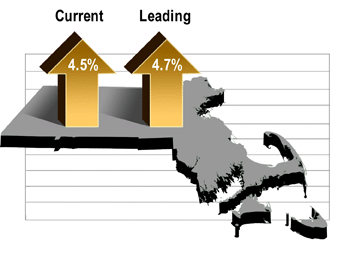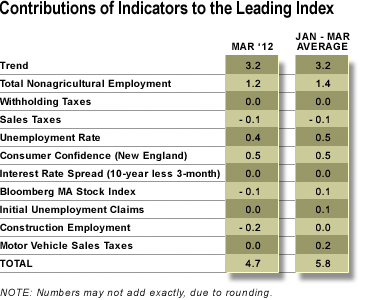State Economic Growth Outpaces that of the Nation in Q1, UMass Journal Reports
March 2012
 The growth in Massachusetts real gross state product increased at a 4.5 percent annualized rate in the first quarter of this year according to the latest Current Economic Index released today by MassBenchmarks, the journal of the Massachusetts economy published by the UMass Donahue Institute in collaboration with the Federal Reserve Bank of Boston.
The growth in Massachusetts real gross state product increased at a 4.5 percent annualized rate in the first quarter of this year according to the latest Current Economic Index released today by MassBenchmarks, the journal of the Massachusetts economy published by the UMass Donahue Institute in collaboration with the Federal Reserve Bank of Boston.
In contrast, the growth in US real gross domestic product increased at a 2.2 percent annualized rate during the same period according to the US Bureau of Economic Analysis. In the fourth quarter of 2011, the Massachusetts economy grew at an estimated 2.9 percent rate as compared to 3.0 percent for the U.S.
The MassBenchmarks Leading Economic Index for March was 4.7 percent, and the three-month average for January through March was 5.8 percent. The leading index is a forecast of the growth in the current index over the next six months, expressed at an annual rate. Thus, it indicates that the economy is expected to grow at an annualized rate of 4.7 percent over the next six months (through September 2012).
 "These estimates of state growth reflect a rapid acceleration in payroll employment, which surged from a 0.9 percent annualized growth in the fourth quarter of last year to a 2.7 percent rate in the first quarter of this year," noted Dr. Alan Clayton-Matthews, MassBenchmarks Senior Contributing Editor and Associate Professor of Economics and Public Policy at Northeastern University, who compiles and analyzes the Current and Leading indices. "In light of the recent large revisions in official estimates of payroll employment, the reliability of this surge in reported employment growth, and therefore the acceleration in state economic growth that is in part based on these payroll estimates, may be overstated," Clayton-Matthews added.
"These estimates of state growth reflect a rapid acceleration in payroll employment, which surged from a 0.9 percent annualized growth in the fourth quarter of last year to a 2.7 percent rate in the first quarter of this year," noted Dr. Alan Clayton-Matthews, MassBenchmarks Senior Contributing Editor and Associate Professor of Economics and Public Policy at Northeastern University, who compiles and analyzes the Current and Leading indices. "In light of the recent large revisions in official estimates of payroll employment, the reliability of this surge in reported employment growth, and therefore the acceleration in state economic growth that is in part based on these payroll estimates, may be overstated," Clayton-Matthews added.
However, several indicators clearly indicate that the state's economy grew at least moderately in the first quarter, and are consistent with strong growth. According to the household survey, the number of Massachusetts residents employed grew at a 1.0 percent rate in the first quarter, while the unemployment rate fell from 6.9 percent in December to 6.5 percent in March, and the labor force held steady. Initial claims for unemployment remained stable at 35,000 per month in the first quarter, a level consistent with a strengthening labor market. Finally, state withholding tax receipts imply that wages and salaries grew at a 7.1 percent annualized rate in the first quarter.
Spending on motor vehicles and items subject to the Commonwealth's regular sales tax fell at a 10.9 percent annualized rate in the first quarter, but that decline was following extraordinary growth of 19.1 percent in the prior quarter. Over the last two quarters, consumer spending on items subject to the sales tax grew at a 3.0 percent annualized rate.
Sales in North American and worldwide semiconductor markets have begun to grow again in the beginning of this year, after a pause in 2011, a year that was affected by the earthquake in Japan and by flooding in Thailand. U.S. industrial production in information processing business equipment expanded at a double-digit annualized rate in the first quarter, a very good sign for the Bay State's technology sectors.
Sales in the Massachusetts housing market continued their upward trend in the first quarter (on a seasonally-adjusted basis), which is consistent with an improving employment picture and rising household incomes, although prices and housing permits have yet to turn up from their depressed levels and the unusually warm winter almost certainly helped to boost sales activity.
"Although the leading index is projecting a continuation of the strong first quarter's performance, it is doubtful that the state's economic growth can continue to outpace that of the U.S. to the extent it appears to have in the first quarter, especially given the weak and uncertain condition of Europe and slowing growth in China," noted Dr. Martin Romitti, MassBenchmarks Managing Editor and Director of Economic and Public Policy Research at the UMass Donahue Institute. "Nevertheless, the state's technology, science, and knowledge-based sectors should continue to provide the support for steady and moderate growth in Massachusetts through the rest of the spring and summer," Romitti concluded.
 The 10 indicators that comprise the leading index usually do not all move in tandem. Typically, some may indicate an expectation of faster than average growth, while at the same time others may indicate an expectation of slower than average growth. The table at left accounts for the contributions of each towards faster or slower growth than the long-term trend of 3.2 percent. The index value is their sum.
The 10 indicators that comprise the leading index usually do not all move in tandem. Typically, some may indicate an expectation of faster than average growth, while at the same time others may indicate an expectation of slower than average growth. The table at left accounts for the contributions of each towards faster or slower growth than the long-term trend of 3.2 percent. The index value is their sum.
In March, three indicators contributed to a forecast of above-trend growth: total nonagricultural employment, the unemployment rate, and consumer confidence. Three indicators contributed to below-trend growth: sales taxes, the Bloomberg stock index for Massachusetts, and construction employment. Four indicators contributed to average-trend growth: withholding taxes, the interest rate spread between 10‑year and 3‑month U.S. Treasury securities, initial unemployment claims, and motor vehicle sales taxes.
In the three-month period January through March, six indicators contributed to a forecast of above-trend growth: total nonagricultural employment, the unemployment rate, consumer confidence, the Bloomberg stock index for Massachusetts, initial unemployment claims, and motor vehicle sales taxes. One indicator, sales taxes, contributed to below-trend growth. Three indicators contributed to average-trend growth: withholding taxes, the interest rate spread between 10‑year and 3‑month U.S. Treasury securities, and construction employment.
The current and historical quarterly estimates for state domestic product growth include adjustments for changes in productivity growth. These adjustments are estimates of the quarterly deviations from trend in the growth of the ratio of output to employment and output to wage and salary income. In the first quarter of 2012, these adjustments subtracted 1.1 percentage points from the annual rate of growth. For the forecast of state domestic product growth for the second and third quarters of this year, productivity growth is assumed to return to its long-term trend. The methodology and rationale for these adjustments are available from the author upon request.
Several recent months of the indices are revised each release. These revisions are a result of the statistical method used to create the index, as well as revisions in the underlying indicators.
--------
All of the indicators except interest rates refer to Massachusetts. The current index is composed of four indicators: nonagricultural employment, withholding taxes, sales taxes, and the unemployment rate. The leading index includes these four current indicators plus the other six (leading) indicators in the contributions table. All of the indicators are as of March, except for interest rates, and the Bloomberg stock index for Massachusetts, which are through April 23. The MassInsight Consumer Confidence Index is released every third month. Intervening months are interpolated, and changes in the Conference Board's Consumer Confidence Index for the U.S. are used to extrapolate to the current month of the index, as needed. Series measured in dollars, i.e., withholding taxes, sales taxes, the Bloomberg stock index, and motor vehicle sales taxes, are deflated by the U.S. consumer price index for all urban consumers, excluding food and energy.
For a description of the methodology used to construct these indices, see: Alan Clayton-Matthews and James H. Stock, "An application of the Stock/Watson index methodology to the Massachusetts economy", Journal of Economic and Social Measurement, vol. 25 (1998/1999), pp. 183-233.
April 27, 2012
Dr. Alan Clayton-Matthews
Senior Contributing Editor, MassBenchmarks

